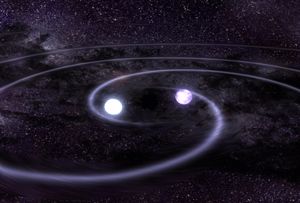Imagine the Universe News - 27 July 2005
Orbiting Stars Flooding Space With Exotic Gravitational Waves
| 27 July 2005 |
A scientist using NASA's Chandra X-ray Observatory has found that two white dwarf stars orbiting each other in a death grip, destined to merge spectacularly, may be flooding space right now with gravitational waves. These waves are ripples in space-time predicted by Einstein but never detected directly.

|
| As a pair of white dwarfs steadily spiral inward, they churn the sea of space-time. The gravitational waves become more intense as the stars accelerate faster and faster, edging ever closer to a merger. Click on image to view animation (6.9 MB). Credit: NASA/Dana Berry, Sky Works Digital (Description) |
Dr. Tod Strohmayer of NASA Goddard Space Flight Center has found that the system's orbit appears to be shrinking about one inch per hour. This is consistent with Einstein's equations. The stars -- only about 50,000 miles apart, a fifth of the distance from the Earth to the Moon -- are whipping around in excess of a million miles per hour. As the stars steadily spiral inward, they churn the sea of space-time and release more and more gravitational waves.
If these measurements are confirmed, this star system would be one of the brightest known sources of gravitational waves and among the first to be detected directly with an upcoming space mission called LISA, the Laser Interferometer Space Antenna.
"This source might be releasing more gravitational waves right now than light waves," said Strohmayer, who presents his results today at the American Astronomical Society meeting in Minneapolis, Minn. "When LISA searches for gravitational wave sources, this one might stick out like a sore thumb."
Einstein predicted that accelerating, massive objects emit gravitational waves, which propagate through space at light speed. A passing wave will cause the Earth, Moon and all matter to bob, like a buoy on the ocean. Chandra cannot detect these waves directly; special instruments like LISA are needed.
White dwarfs are remnants of stars like our Sun that have used up all their fuel. White dwarfs, along with neutron stars and black holes, are called compact objects because they pack a lot of mass into a small volume. White dwarfs have about half the mass of the Sun, yet are only about the size of Earth. Being compact, white dwarfs can find themselves in very tight orbits.
The orbit of this white dwarf pair, called RX J0806.3+1527, might be the smallest of any binary in the Galaxy. The system's orbital period is 321.5 seconds -- barely more than five minutes -- and is decreasing by 1.2 milliseconds every year. The five-minute period is likely the system's orbital period, but definitive confirmation of this fact awaits. The other possibility is that it represents the spin period of one of its white dwarfs.
"It's either the most compact binary known or one of the most unusual systems we've ever seen," said Strohmayer. "Either way it's got a great story to tell."
Strohmayer's Chandra X-ray observation tightens orbital decay estimates made through optical observations in recent years independently by teams led by GianLuca Israel of the Astronomical Observatory of Rome and by Pasi Hakala of the University of Helsinki.
This white dwarf pair is similar to the orbiting neutron stars leaking gravitational waves discovered by Russell Hulse and Joseph Taylor, who won the 1993 Nobel Prize in Physics. Similar binary stars have been detected since then. While this new star system is not as well characterized as the Hulse-Taylor system, the stars could be about 1,000 times brighter in gravitational waves if the orbit is indeed shortening and quickening, as the data suggest.
With Chandra data, Strohmayer calculated that the system's five-minute period is speeding up at a rate of 3.6x10-16 hertz per second. Although small sounding, this number is big in the realm of orbital decays -- 100,000 times larger than that of the Hulse-Taylor pulsar with its eight-hour orbit, for example.

